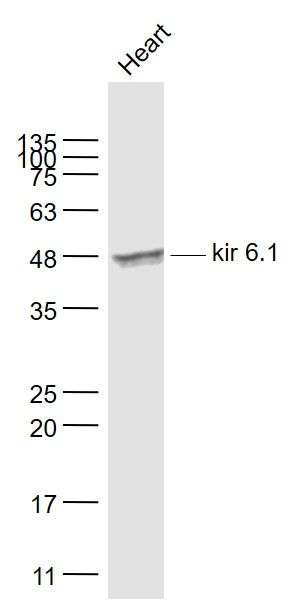产品货号 : mlR6468
英文名称 : kir 6.1
中文名称 : ATP敏感钾离子通道蛋白抗体
别 名 : Kir6.1; inwardly rectifying subfamily J member 8; ATP sensitive inward rectifier potassium channel 8; ATP-sensitive inward rectifier potassium channel 8; Inward rectifier K(+) channel Kir6.1; Inwardly rectifier K(+) channel Kir6.1; Inwardly rectifying potassium channel Kir6.1; IRK 8; IRK8; IRK8_HUMAN; KCNJ8; kir 6.1; Potassium channel; Potassium channel, inwardly rectifying subfamily J member 8; potassium inwardly rectifying channel J8; uKATP 1; uKATP-1.
研究领域 : 肿瘤 心血管 细胞生物 免疫学 神经生物学 通道蛋白
抗体来源 : Rabbit
克隆类型 : Polyclonal
交叉反应 : Human, Mouse, Rat, Chicken, Pig, Cow, Rabbit,
产品应用 : WB=1:500-2000 ELISA=1:500-1000
not yet tested in other applications.
optimal dilutions/concentrations should be determined by the end user.
分 子 量 : 48kDa
细胞定位 : 细胞膜
性 状 : Lyophilized or Liquid
浓 度 : 1mg/ml
免 疫 原 : KLH conjugated synthetic peptide derived from human kir 6.1:61-160/424 <Extracellular>
亚 型 : IgG
纯化方法 : affinity purified by Protein A
储 存 液 : 0.01M TBS(pH7.4) with 1% BSA, 0.03% Proclin300 and 50% Glycerol.
保存条件 : Store at -20 °C for one year. Avoid repeated freeze/thaw cycles. The lyophilized antibody is stable at room temperature for at least one month and for greater than a year when kept at -20°C. When reconstituted in sterile pH 7.4 0.01M PBS or diluent of antibody the antibody is stable for at least two weeks at 2-4 °C.
PubMed : PubMed
产品介绍 : This potassium channel is controlled by G proteins. Inward rectifier potassium channels are characterized by a greater tendency to allow potassium to flow into the cell rather than out of it. Their voltage dependence is regulated by the concentration of extracellular potassium; as external potassium is raised, the voltage range of the channel opening shifts to more positive voltages. The inward rectification is mainly due to the blockage of outward current by internal magnesium. Can be blocked by external barium.
Function:
This potassium channel is controlled by G proteins. Inward rectifier potassium channels are characterized by a greater tendency to allow potassium to flow into the cell rather than out of it. Their voltage dependence is regulated by the concentration of extracellular potassium; as external potassium is raised, the voltage range of the channel opening shifts to more positive voltages. The inward rectification is mainly due to the blockage of outward current by internal magnesium. Can be blocked by external barium (By similarity).
Subcellular Location:
Membrane; Multi-pass membrane protein.
Tissue Specificity:
Predominantly detected in fetal and adult heart.
DISEASE:
Note=Defects in KCNJ8 may be associated with susceptibility to J-wave syndromes, a group of heart disorders characterized by early repolarization events as indicated by abnormal J-wave manifestation on electrocardiogram (ECG). The J point denotes the junction of the QRS complex and the ST segment on the ECG, marking the end of depolarization and the beginning of repolarization. An abnormal J wave is a deflection with a dome or hump morphology immediately following the QRS complex of the surface ECG. Examples of J-wave disorders are arrhythmias associated with an early repolarization pattern in the inferior or mid to lateral precordial leads, Brugada syndrome, some cases of idiopathic ventricular fibrillation (VF) with an early repolarization pattern in the inferior, inferolateral or global leads, as well as arrhythmias associated with hypothermia.
Defects in KCNJ8 may be a cause of susceptibility to sudden infant death syndrome (SIDS) [MIM:272120]. SIDS is the sudden death of an infant younger than 1 year that remains unexplained after a thorough case investigation, including performance of a complete autopsy, examination of the death scene, and review of clinical history. Pathophysiologic mechanisms for SIDS may include respiratory dysfunction, cardiac dysrhythmias, cardiorespiratory instability, and inborn errors of metabolism, but definitive pathogenic mechanisms precipitating an infant sudden death remain elusive.
Similarity:
Belongs to the inward rectifier-type potassium channel (TC 1.A.2.1) family. KCNJ8 subfamily.
SWISS:
Q15842
Gene ID:
3764
Important Note:
This product as supplied is intended for research use only, not for use in human, therapeutic or diagnostic applications.
产品图片












